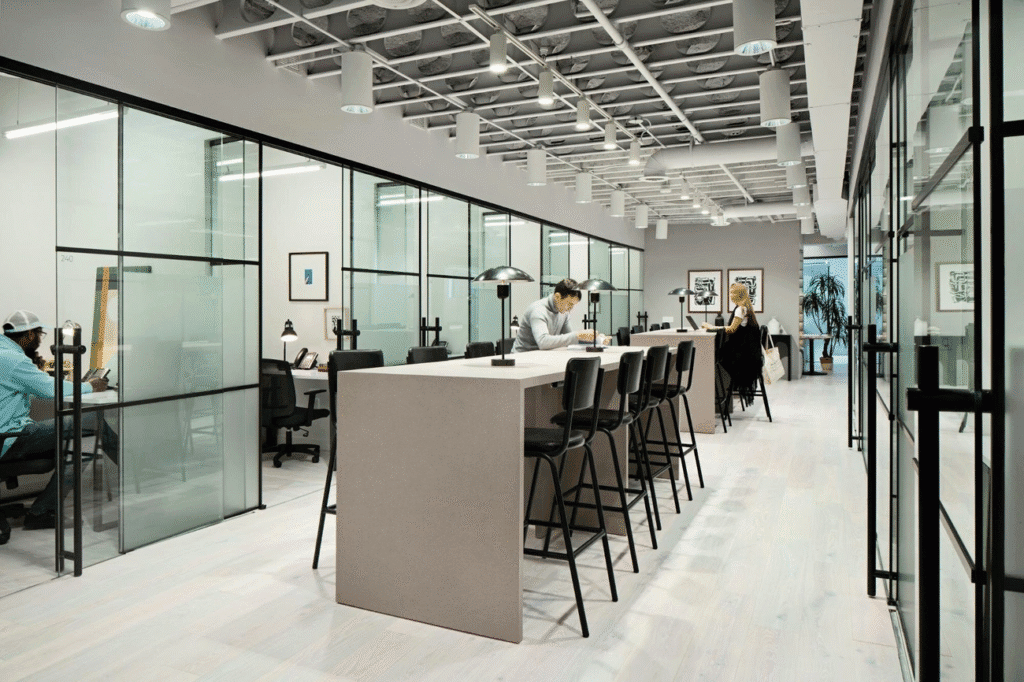Did you know that 91% of employees worldwide prefer to work fully or almost completely remotely? This striking preference is reshaping hybrid work solutions as we head toward 2025.
Even though employees feel this way, 83% of CEOs think everyone will be back in the office within three years. This gap creates a big problem for managers like us who must balance what the company wants with what workers expect. In fact, office attendance has stayed at about 50% of what it was before the pandemic for almost two years, showing that the hybrid workplace isn’t going away.
Getting your hybrid work model right has big payoffs. Companies that put money into good hybrid workplace tech see their employees 230% more engaged and 85% more likely to stay with the company. Furthermore, as we get closer to 2025, hybrid work trends show more use of AI and automation to make workflows smoother and teamwork better.
This guide offers hands-on tips to create effective hybrid work solutions that get your company ready for the future of hybrid work. We’ll cover everything from picking the right tech tools to solving common problems, giving you useful insights to help you build a successful hybrid setup that works for everyone.
Why Hybrid Work Needs a New Plan in 2025
As we enter 2025, people are talking about hybrid work in a whole new way. Hybrid workplaces are no longer just a quick fix but a key part of business strategy that needs careful planning. With 77% of organizations now using a hybrid work model, we’re seeing a big change in how companies think about work arrangements.
The move from place to teamwork
The hybrid work shift has gone beyond just deciding where people work—it’s now about how companies change. At first, businesses cared about physical presence, often setting random rules for office time. But this view misses what hybrid work can do.
Today’s hybrid work answers focus on improving teamwork, not just tracking where people are. One study indicates that online meetings and being remote can make people feel alone and cut off even when they’re in the same virtual room. This lonely feeling comes from fewer body language clues, more brain strain, and screen tiredness—problems that need smart fixes, not just telling people to come to the office.
For businesses where success hinges on close daily teamwork and sharing knowledge, working together in person stays essential. Still, the best hybrid work setups in 2025 zero in on bringing people together with a purpose instead of random schedules.
Why giving people choices isn’t enough on its own
While having options is important, too much freedom can lead to significant problems. Initially, many bosses believed that hybrid work would effectively balance flexibility and teamwork. But this idea missed some key points, including different views on what “hybrid work” means.
A full hybrid plan needs:
- Clear rules for how people talk to each other, both when working from home and at the office
- Tech tools that work together so people can team up no matter where they are
- Well-planned approaches to hybrid scheduling that find a balance between what individuals want and what teams need
Offering flexibility without a clear plan leads to coordination issues, as 55% of employees report learning new skills more effectively in a well-defined hybrid setup. Furthermore, when given total freedom, most workers will take Monday and Friday off, with 36% choosing to come in on Friday compared to 82% on Wednesday. This behavior leads to significant challenges in effectively utilizing office space and maintaining team synchronization.
Matching hybrid work with company goals
Above all, successful hybrid work plans for 2025 must support wider company goals. Hybrid work makes it difficult to maintain team alignment because it disrupts traditional methods of communication, collaboration, and visibility. When things get out of sync, it leads to scattered efforts and wasted resources.
Staff members may lose sight of the significance of their job when they don’t comprehend the company’s actions, goals, or strategies. Such an attitude can make them less focused and engaged. So, companies need systems like OKRs (Objectives and Key Results) to help teams link up and spot work that backs the company’s mission.
For hybrid models to be successful, they need to strike a balance between company requirements and staff expectations. Instead of tracking hours or keystrokes, successful hybrid companies in 2025 put their focus on results. When you trust workers to manage their schedules and evaluate them based on the outcomes they’ve promised to deliver, they become more productive and engaged.
When companies put these smart hybrid work strategies into action, they can see big rewards. Businesses with good hybrid setups report happier employees, better output, and more people staying in their jobs compared to companies that are all-remote or all-office.
Picking the Right Hybrid Work Model
Finding the right hybrid work setup requires careful consideration of various factors. Research shows that bosses in all kinds of jobs still find it difficult to make rules that balance their wish for people to come to the office with workers’ ongoing desire to work. At the same time, team leaders face problems keeping their teams interested when there’s so much change and tiredness.
Learning about different hybrid setups
A few clear hybrid work models have shown up, each with its own special features:
- In a fixed hybrid model, employees adhere to predetermined schedules that specify their remote and office workdays. Companies like Google and Microsoft implement this approach, providing consistency and predictability.
- Free hybrid model – Workers pick their mix of home and office work based on what they like and how they work best. Companies like Airbnb and Spotify like this approach.
- Office-first hybrid – The office stays the main workspace, allowing occasional remote days. This setup boosts face-to-face teamwork but reduces flexibility.
- Remote-first hybrid – Remote work becomes the norm, with the office acting as a sporadic meeting place. Companies like Dropbox and Shopify use this model to access worldwide talent.
Studies reveal that 84% of workers want to visit the office 2–4 days each week, while 16% prefer extreme schedules (remote or in-office).
Striking a balance between remote and in-office needs
Striking the right balance requires grasping both company goals and worker preferences. According to a Stanford economist, hybrid work benefits employee productivity, performance, and retention. But this balance doesn’t happen on its own.
As you craft your hybrid policy, think about:
- Teamwork needs – Figure out which jobs and duties gain from face-to-face interaction
- Worker feedback – Get input from employees as you shape your policy
- Set hours – Think about setting up “core hours” (like 10am-2pm) when everyone must be reachable, no matter where they are
- Clear rules – Spell out what you expect from workers to get approvals and work with their teams
Remote work has an impact on individual focus, while office time influences team activities in many companies. Compared to before, 49% of workers now see the office as a place to socialize, plan strategies, train new hires, and acquire skills.
Steering clear of one-size-fits-all rules
To create effective hybrid policies, it’s crucial to tailor them to your company’s unique needs. Studies indicate that hybrid setups that benefit one business might not work for another even in the same field.
Rather than blanket rules, think about:
- Team-based methods – Let teams choose which days they need to be in the office, setting targets like two days a week but allowing teams to decide what suits them best
- Rolling out in stages – Try out different setups before going all in
- Checking in often – Look at and tweak rules based on what the business needs as things change
It’s worth mentioning that when companies told everyone to come back to the office, workers pushed back right away. A health tech company successfully adapted its approach by changing the message from “You have to come to the office” to “You’ll want to come to the office,” allowing workers more input in the decision.
When you take a close look at what your company needs and get your team involved in making choices, you can create a mix of office and remote work that boosts output while giving workers the freedom they want. In the end, the best mixed work plans focus on results, not just showing up, and trust workers to get their jobs done regardless of where they are.
Building the Right Technology Stack
Your hybrid work strategy’s success depends on the technology stack that supports it. Companies report 83% better teamwork in hybrid settings, so picking the right tools matters a lot for long-term achievements.
Key tools to communicate and work together
Good hybrid workplaces need strong communication tech as a base. Video calls have become a must, with 25% of work meetings happening face-to-face by 2024. Your toolkit should have:
- All-in-one messaging systems like Slack or Microsoft Teams that allow quick and delayed communication through instant messages, file sharing, and topic-based groups
- Video conferencing solutions that link far-flung teams with features like screen sharing meeting recording, and breakout rooms
- Project management software like Asana or Trello to keep tabs on workflows no matter where employees are
These tools do more than just enable talks—they build digital workspaces where teams can work together. Take Microsoft Teams, for example. It lets users sort communication into specific team channels, keeping client and project info in one place.
Integrating hybrid work platforms
Beyond individual tools, companies need to think about integration for hybrid work to succeed. Management systems that fully integrate allow companies to streamline how they communicate and cut down on time spent jumping between apps.
Cloud technology has a key impact here, giving people access to information around the clock while letting companies scale up or down as the number of remote workers changes. This integration should also extend to physical spaces, with smart office tech that connects people in the office and those working through apps for meeting rooms and booking desks.
Integration doesn’t just boost productivity—it makes work better for employees. As tech experiences shape how employees feel about their work in hybrid setups, platforms that integrate well create smooth workflows that cut down on hassles.
Ensuring seamless access and support
Hybrid workforces use many devices—servers, laptops, smartphones, and tablets—which makes IT support more tricky. Endpoint management solutions help to monitor, detect, and prevent problems in one system.
Safety stays crucial throughout.
- Platforms with end-to-end encryption for emails, video calls, and file sharing
- Virtual Private Networks (VPNs) to encode data and shield it from hackers
- Access controls based on roles so cleared employees can see certain data
Also, offering round-the-clock IT support with active monitoring helps remote workers resolve tech issues without much delay. Automating device management jobs eases the load on IT teams while cutting down setup time.
Overcoming Key Challenges in Hybrid Work
Developing effective hybrid work solutions means tackling three key issues that managers deal with every day. When teams work from different locations, these issues can disrupt even the most well-designed hybrid work plans if they are not addressed.
Keeping teams involved and preserving company culture
Research indicates that the biggest reason people feel disconnected in hybrid workplaces is the lack of social bonds. Remote workers may feel isolated and miss the camaraderie of in-office teams. A study found that 25% of remote or hybrid knowledge workers feel a connection to their company’s culture, which shows how big this problem is.
Creating a unified culture in the hybrid workplace needs thoughtful plans. Companies that keep workers engaged see 22% more productivity and 23% higher profits than those that don’t focus on engagement. So, setting up regular online team activities and starting mentoring programs can help build connections, regardless of where staff work.
Overseeing work without being overbearing
Since COVID-19 hit, 42% of workers say their bosses watch them more closely, which hurts hybrid work. Furthermore, 48% of employees think their managers trust them less, with 20% saying constant oversight is the worst part of working from home.
Managing performance in hybrid work setups means focusing on results instead of tracking time or keystrokes. Bosses should schedule regular meetings to check progress and see if goals still make sense. Studies show that asking for input cuts stress by half for both sides, making it a good practice in hybrid work.
Tackling cybersecurity and compliance risks
Hybrid work increases the chances of cyber attacks. Companies face several big risks:
- Unsafe home Wi-Fi and public networks
- Scam emails taking advantage of digital communication tools
- Security problems with personal devices
- People making mistakes and insider threats
About 80% of companies store personal data on their workers’ devices, which raises big compliance issues. Additionally, companies must determine the tax implications when employees work in various locations.
In the end, to make hybrid work successful, companies need to think about these problems and balance what people need with what the company needs.
Getting Ready for Hybrid Work’s Future

Image Source: Bond Collective
There will be significant changes in hybrid work. As we look past how we do things now, new tech will change how hybrid teams work together.
How AI and automation fit in
AI adoption is speeding up in hybrid work settings, with 94% of business leaders now using AI in their day-to-day operations. But this shift has its problems—worker excitement about generative AI fell from 45% to 36% in just three months in 2024. This gap exists because while 85% of executives are forcing AI use, 77% of workers say it has made them less productive.
What is the primary problem? Only 26% of workers get training on AI tools. Companies that do well with flexible work are in a better spot to bring in new AI ideas because both need similar foundations of trust and investment. By doing routine tasks and giving smart help, AI can make workflows smoother—84% of leaders say AI has made their organizations more productive.
Emerging hybrid work trends to watch
As we look to the future, several key trends will shape the hybrid workplace:
- Human-AI teaming: We’re moving past current tools toward AI agents that act as true co-workers. These agents will have the ability to understand context, adjust to new information, and work with humans on complex tasks.
- Metaverse integration: Virtual reality offices will make collaboration more immersive.
- Four-day workweeks: Companies like Microsoft Japan are already testing this. They report a 40% boost in productivity.
- Generational expectations: Gen Z will make up most of the workforce by 2030. About 67% of them want the flexibility of hybrid work.
Creating a future-ready hybrid workplace
Creating a robust hybrid work model requires striking a balance between human and AI capabilities. Moravec’s Paradox suggests that tasks humans find challenging, such as complex calculations, are straightforward for computers. Conversely, computers struggle with social skills that are inherent to humans.
The hybrid workplaces of tomorrow need to shift their focus from where people work to how teams work. This shift calls for investment in technologies that boost collaboration and set up clear guidelines for human-AI interaction. Leaders who zero in on this “interaction fit” will gain an edge through better productivity, new ideas, and cost savings.
Conclusion
As we approach 2025, hybrid work solutions have grown from emergency measures to key strategies. The gap between what employees want and what executives expect creates big challenges for managers. Still, companies that put hybrid work models in place see big benefits, like more engaged workers, higher productivity, and better employee retention.
The best hybrid approaches look at results, not just who’s in the office. They also strike a balance between being flexible and having structure, with clear rules for communication and tech that makes teamwork easy no matter where people are. Choosing the appropriate model, whether it’s fixed, flexible, office-first, or remote-first, requires a thorough understanding of your company’s needs, rather than adopting a universal solution.
Tech is the backbone of successful hybrid work setups. So, putting money into all-in-one chat platforms, task trackers, and safety measures builds the base for a smooth rollout. Besides tech, you need solid plans to tackle issues like keeping team spirit alive, checking work without being too pushy, and cutting down on safety risks.
AI and robots will transform the nature of hybrid work in the future. Companies that do well won’t care so much about where people work but how teams work together. Above all, keep in mind that hybrid work works with trust, clear goals, and being ready to change when things shift.
The workplace of tomorrow belongs to those who can strike a balance between company goals and staff needs while adopting new tech and trends. We face some hurdles, but we now have the know-how and resources to build hybrid setups where businesses and workers can thrive.
FAQs
Q1. What makes up a good hybrid work setup?
A robust hybrid work setup prioritizes teamwork quality, establishes clear communication rules, utilizes collaborative technology, and measures success based on results. It strikes a balance between flexibility and structure, aligning with the broader objectives of the company.
Q2. How can managers maintain team engagement in a hybrid work environment?
Managers can keep teams engaged by organizing regular team-building events, initiating mentoring programs, and providing opportunities for people to connect. It’s key to build a feeling of belonging and connection regardless of where employees work.
Q3. What technology is essential for successful hybrid work implementation?
Key tech for hybrid work includes unified messaging tools, video call systems, project tracking software, and cloud-based setups. Platforms that bring everything together, allowing smooth communication and teamwork across different places, are vital.
Q4. How can organizations address cybersecurity risks in a hybrid work setup?
Organizations can address cybersecurity risks by implementing end-to-end encryption through VPNs, establishing role-based access controls, and providing regular security training to employees. It’s also key to have strong endpoint management solutions and IT support around the clock.
Q5. What role will AI play in the future of hybrid work?
AI will have a big impact on making workflows smoother, completing routine tasks , and offering intelligent assistance in hybrid work environments. But to make it work well, companies need to train people and focus on humans and AI working together to boost productivity and come up with new ideas.









































































































